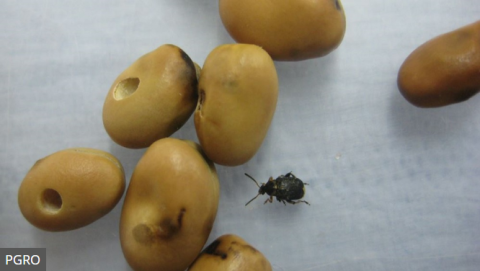Learn about the pest’s life cycle and the opportunities for management, including spray treatment thresholds.
Risk factors in bean crops
- Common in the south of the UK, extending up to Yorkshire
- Risk is greater where fields have recently been affected
- Adults fly into crops when temperature reaches 15–20°C
- Winter and early sown spring crops are at highest risk
Beetle identification
Scientific name: Bruchus rufimanus.
Adults are 3.5–4.5 mm long and black or dark brown with grey flecks on the wing cases which do not extend to cover the abdomen completely. The base of the antennae and front legs are a reddish colour.
Eggs are 0.5 mm long, cigar-shaped and white/yellowish.
Larvae are white with a light brown head and 3–4 mm long at maturity.
Bruchid beetle life cycle and crop damage
Oct–Apr: Adults overwinter in hedgerows or other dense, shrubby habitats.
Mar–May: Adults fly into flowering bean crops when the temperature reaches 15–20°C.
Jun–Jul: Adults feed on pollen for several weeks before laying eggs on pod, predominately at the base of the plant, once temperatures exceed 20°C.
Jun–Sep: Larvae bore into the seed and feed for several months, pupating within it as the seed matures and dries in the field or in storage. Adults emerge from the seed, leaving a circular hole.
There is one generation a year and this pest does not reproduce in stored produce.
Non-chemical and chemical control
Non-chemical control
Later sowing of spring crops can reduce the risk of damage. Autumn crops are at increased risk as flowering and pod set are more likely to coincide with adult activity.
The parasitic wasp, Triaspis luteipes, attacks the beetle larvae. Small emergence holes in the seeds may be due to this natural enemy, which may impact crops destined for higher-quality markets.
Monitoring
Crops should be examined for adults during flowering. This can be done by tapping the flowering stems into the hand or a shallow tray.
Thresholds
Treatment should be applied when adults have been found in the crop, the temperature has reached 20°C on two consecutive days and beans have developed the first pods on the lowest trusses. Applying in the evening or at night will reduce the risk to foraging bees.
Insecticide resistance
None known.




